Nursing Case Study: An Educative Care Plan for Osteoarthritis
VerifiedAdded on 2024/05/30
|15
|2974
|152
Case Study
AI Summary
This nursing case study focuses on Irim, a 31-year-old nurse diagnosed with osteoarthritis, and emphasizes the importance of health education in her care. The assignment highlights the role of nurses in promoting healthy lifestyles and preventing disease, aligning with national standards for registered nurses. It discusses health literacy, its impact on patient outcomes, and various personal and external factors influencing it. The case study details osteoarthritis, its causes, symptoms, and diagnostic methods. An educative care plan is developed for Irim, addressing weight management, exercise, and the involvement of various health professionals like psychiatrists, physiotherapists, and dieticians. The plan includes assessing the patient's posture, weight, range of motion, and ability to perform daily activities, along with educating her on assistive devices and promoting mobility through exercise and a healthy diet. Desklib offers similar solved assignments and study resources for students.
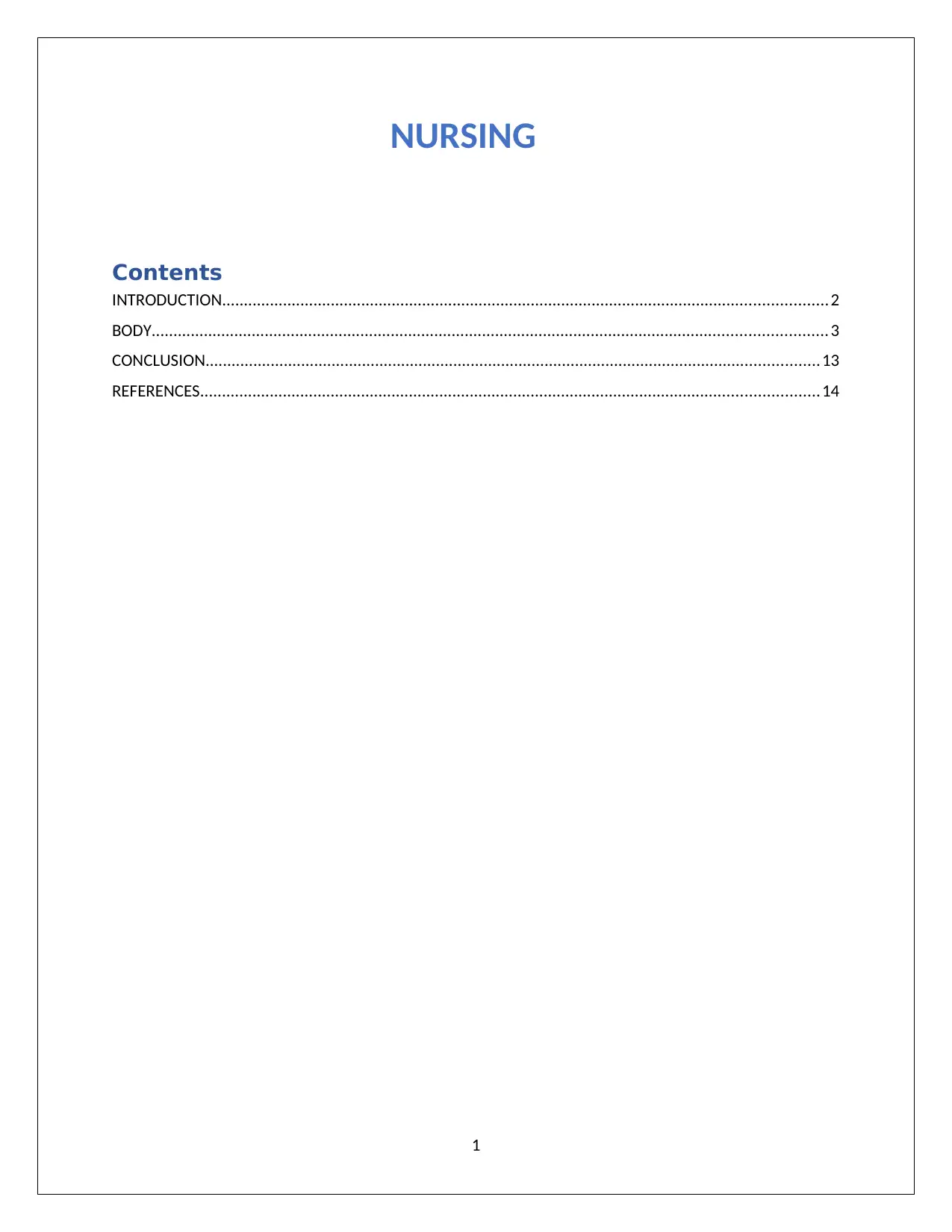
NURSING
Contents
INTRODUCTION...........................................................................................................................................2
BODY...........................................................................................................................................................3
CONCLUSION.............................................................................................................................................13
REFERENCES..............................................................................................................................................14
1
Contents
INTRODUCTION...........................................................................................................................................2
BODY...........................................................................................................................................................3
CONCLUSION.............................................................................................................................................13
REFERENCES..............................................................................................................................................14
1
Paraphrase This Document
Need a fresh take? Get an instant paraphrase of this document with our AI Paraphraser
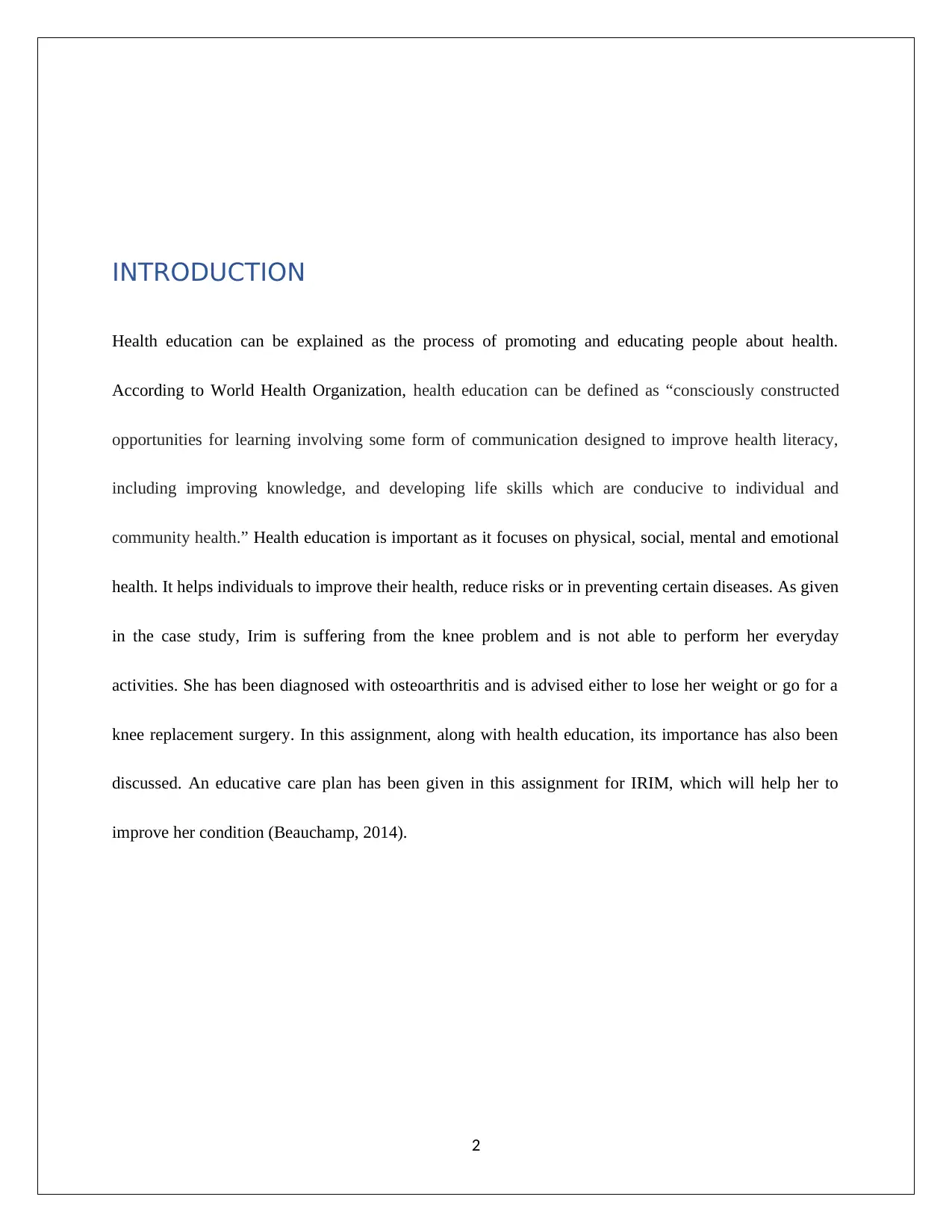
INTRODUCTION
Health education can be explained as the process of promoting and educating people about health.
According to World Health Organization, health education can be defined as “consciously constructed
opportunities for learning involving some form of communication designed to improve health literacy,
including improving knowledge, and developing life skills which are conducive to individual and
community health.” Health education is important as it focuses on physical, social, mental and emotional
health. It helps individuals to improve their health, reduce risks or in preventing certain diseases. As given
in the case study, Irim is suffering from the knee problem and is not able to perform her everyday
activities. She has been diagnosed with osteoarthritis and is advised either to lose her weight or go for a
knee replacement surgery. In this assignment, along with health education, its importance has also been
discussed. An educative care plan has been given in this assignment for IRIM, which will help her to
improve her condition (Beauchamp, 2014).
2
Health education can be explained as the process of promoting and educating people about health.
According to World Health Organization, health education can be defined as “consciously constructed
opportunities for learning involving some form of communication designed to improve health literacy,
including improving knowledge, and developing life skills which are conducive to individual and
community health.” Health education is important as it focuses on physical, social, mental and emotional
health. It helps individuals to improve their health, reduce risks or in preventing certain diseases. As given
in the case study, Irim is suffering from the knee problem and is not able to perform her everyday
activities. She has been diagnosed with osteoarthritis and is advised either to lose her weight or go for a
knee replacement surgery. In this assignment, along with health education, its importance has also been
discussed. An educative care plan has been given in this assignment for IRIM, which will help her to
improve her condition (Beauchamp, 2014).
2
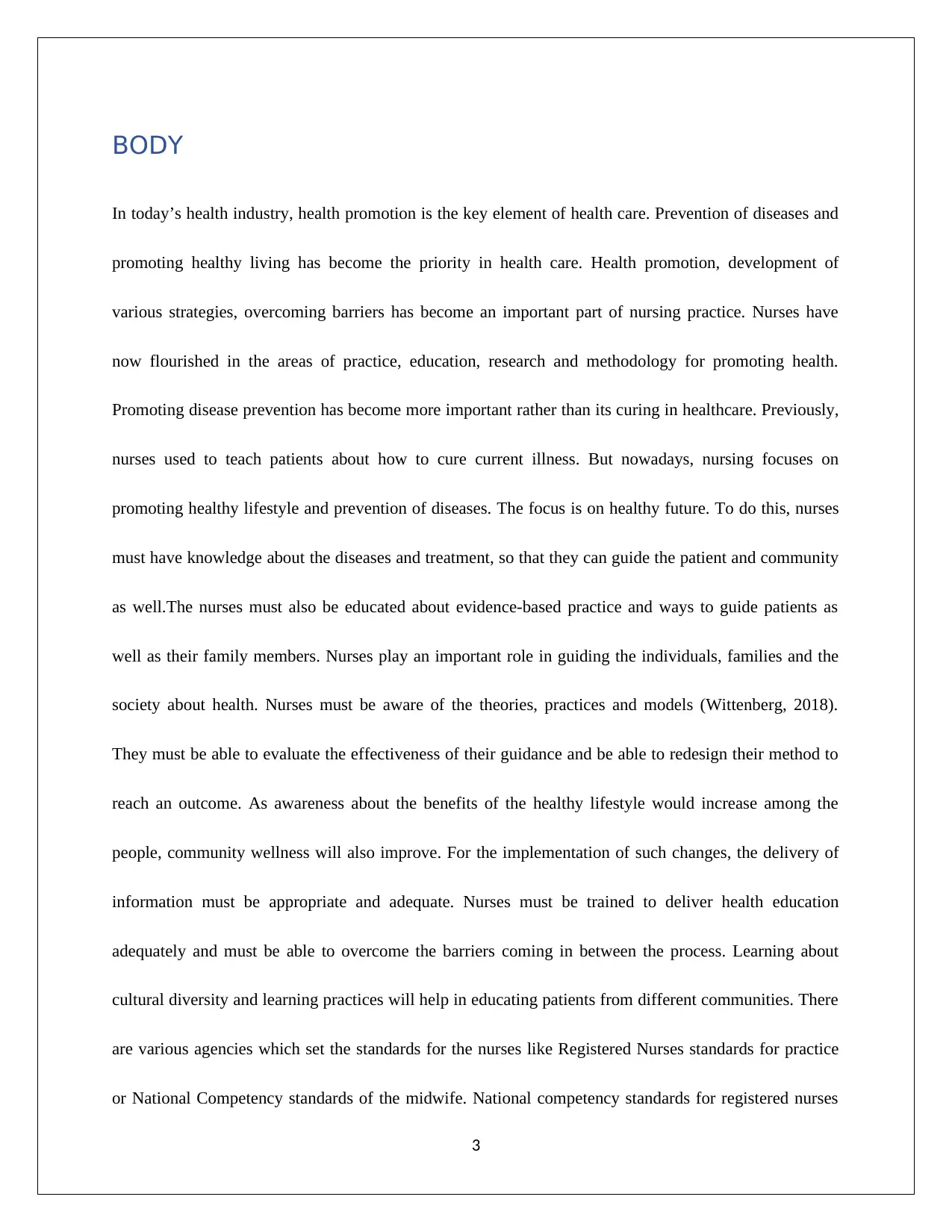
BODY
In today’s health industry, health promotion is the key element of health care. Prevention of diseases and
promoting healthy living has become the priority in health care. Health promotion, development of
various strategies, overcoming barriers has become an important part of nursing practice. Nurses have
now flourished in the areas of practice, education, research and methodology for promoting health.
Promoting disease prevention has become more important rather than its curing in healthcare. Previously,
nurses used to teach patients about how to cure current illness. But nowadays, nursing focuses on
promoting healthy lifestyle and prevention of diseases. The focus is on healthy future. To do this, nurses
must have knowledge about the diseases and treatment, so that they can guide the patient and community
as well.The nurses must also be educated about evidence-based practice and ways to guide patients as
well as their family members. Nurses play an important role in guiding the individuals, families and the
society about health. Nurses must be aware of the theories, practices and models (Wittenberg, 2018).
They must be able to evaluate the effectiveness of their guidance and be able to redesign their method to
reach an outcome. As awareness about the benefits of the healthy lifestyle would increase among the
people, community wellness will also improve. For the implementation of such changes, the delivery of
information must be appropriate and adequate. Nurses must be trained to deliver health education
adequately and must be able to overcome the barriers coming in between the process. Learning about
cultural diversity and learning practices will help in educating patients from different communities. There
are various agencies which set the standards for the nurses like Registered Nurses standards for practice
or National Competency standards of the midwife. National competency standards for registered nurses
3
In today’s health industry, health promotion is the key element of health care. Prevention of diseases and
promoting healthy living has become the priority in health care. Health promotion, development of
various strategies, overcoming barriers has become an important part of nursing practice. Nurses have
now flourished in the areas of practice, education, research and methodology for promoting health.
Promoting disease prevention has become more important rather than its curing in healthcare. Previously,
nurses used to teach patients about how to cure current illness. But nowadays, nursing focuses on
promoting healthy lifestyle and prevention of diseases. The focus is on healthy future. To do this, nurses
must have knowledge about the diseases and treatment, so that they can guide the patient and community
as well.The nurses must also be educated about evidence-based practice and ways to guide patients as
well as their family members. Nurses play an important role in guiding the individuals, families and the
society about health. Nurses must be aware of the theories, practices and models (Wittenberg, 2018).
They must be able to evaluate the effectiveness of their guidance and be able to redesign their method to
reach an outcome. As awareness about the benefits of the healthy lifestyle would increase among the
people, community wellness will also improve. For the implementation of such changes, the delivery of
information must be appropriate and adequate. Nurses must be trained to deliver health education
adequately and must be able to overcome the barriers coming in between the process. Learning about
cultural diversity and learning practices will help in educating patients from different communities. There
are various agencies which set the standards for the nurses like Registered Nurses standards for practice
or National Competency standards of the midwife. National competency standards for registered nurses
3
⊘ This is a preview!⊘
Do you want full access?
Subscribe today to unlock all pages.

Trusted by 1+ million students worldwide
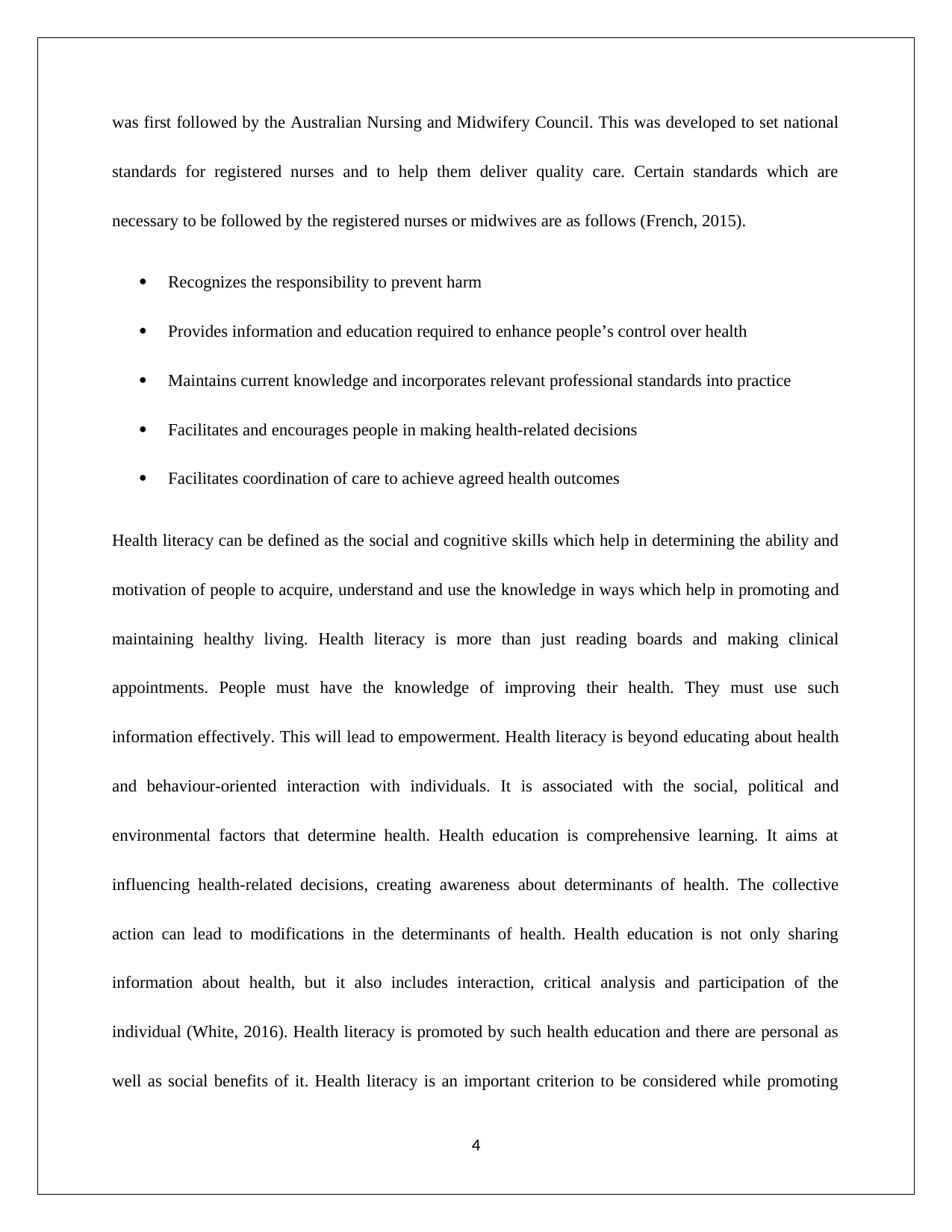
was first followed by the Australian Nursing and Midwifery Council. This was developed to set national
standards for registered nurses and to help them deliver quality care. Certain standards which are
necessary to be followed by the registered nurses or midwives are as follows (French, 2015).
Recognizes the responsibility to prevent harm
Provides information and education required to enhance people’s control over health
Maintains current knowledge and incorporates relevant professional standards into practice
Facilitates and encourages people in making health-related decisions
Facilitates coordination of care to achieve agreed health outcomes
Health literacy can be defined as the social and cognitive skills which help in determining the ability and
motivation of people to acquire, understand and use the knowledge in ways which help in promoting and
maintaining healthy living. Health literacy is more than just reading boards and making clinical
appointments. People must have the knowledge of improving their health. They must use such
information effectively. This will lead to empowerment. Health literacy is beyond educating about health
and behaviour-oriented interaction with individuals. It is associated with the social, political and
environmental factors that determine health. Health education is comprehensive learning. It aims at
influencing health-related decisions, creating awareness about determinants of health. The collective
action can lead to modifications in the determinants of health. Health education is not only sharing
information about health, but it also includes interaction, critical analysis and participation of the
individual (White, 2016). Health literacy is promoted by such health education and there are personal as
well as social benefits of it. Health literacy is an important criterion to be considered while promoting
4
standards for registered nurses and to help them deliver quality care. Certain standards which are
necessary to be followed by the registered nurses or midwives are as follows (French, 2015).
Recognizes the responsibility to prevent harm
Provides information and education required to enhance people’s control over health
Maintains current knowledge and incorporates relevant professional standards into practice
Facilitates and encourages people in making health-related decisions
Facilitates coordination of care to achieve agreed health outcomes
Health literacy can be defined as the social and cognitive skills which help in determining the ability and
motivation of people to acquire, understand and use the knowledge in ways which help in promoting and
maintaining healthy living. Health literacy is more than just reading boards and making clinical
appointments. People must have the knowledge of improving their health. They must use such
information effectively. This will lead to empowerment. Health literacy is beyond educating about health
and behaviour-oriented interaction with individuals. It is associated with the social, political and
environmental factors that determine health. Health education is comprehensive learning. It aims at
influencing health-related decisions, creating awareness about determinants of health. The collective
action can lead to modifications in the determinants of health. Health education is not only sharing
information about health, but it also includes interaction, critical analysis and participation of the
individual (White, 2016). Health literacy is promoted by such health education and there are personal as
well as social benefits of it. Health literacy is an important criterion to be considered while promoting
4
Paraphrase This Document
Need a fresh take? Get an instant paraphrase of this document with our AI Paraphraser
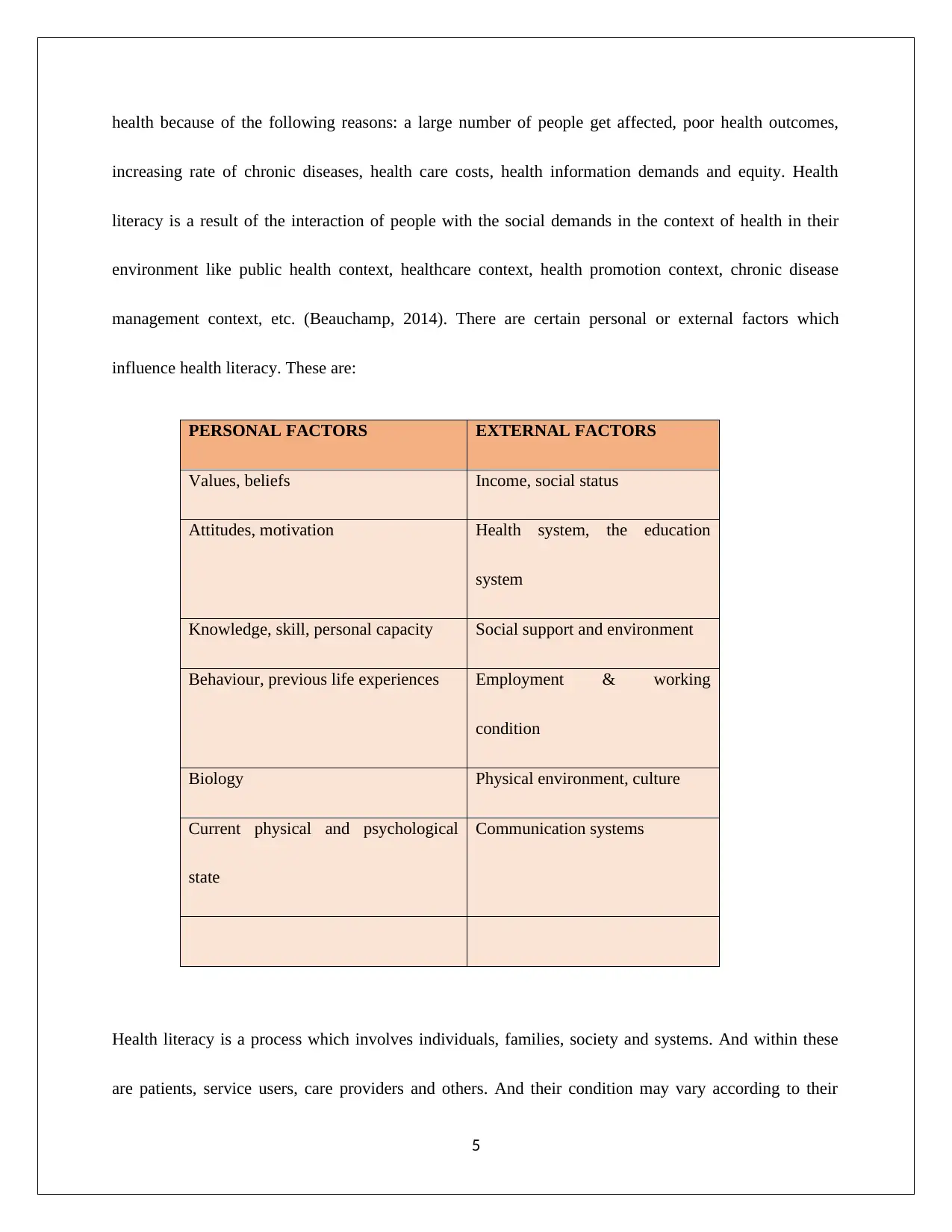
health because of the following reasons: a large number of people get affected, poor health outcomes,
increasing rate of chronic diseases, health care costs, health information demands and equity. Health
literacy is a result of the interaction of people with the social demands in the context of health in their
environment like public health context, healthcare context, health promotion context, chronic disease
management context, etc. (Beauchamp, 2014). There are certain personal or external factors which
influence health literacy. These are:
PERSONAL FACTORS EXTERNAL FACTORS
Values, beliefs Income, social status
Attitudes, motivation Health system, the education
system
Knowledge, skill, personal capacity Social support and environment
Behaviour, previous life experiences Employment & working
condition
Biology Physical environment, culture
Current physical and psychological
state
Communication systems
Health literacy is a process which involves individuals, families, society and systems. And within these
are patients, service users, care providers and others. And their condition may vary according to their
5
increasing rate of chronic diseases, health care costs, health information demands and equity. Health
literacy is a result of the interaction of people with the social demands in the context of health in their
environment like public health context, healthcare context, health promotion context, chronic disease
management context, etc. (Beauchamp, 2014). There are certain personal or external factors which
influence health literacy. These are:
PERSONAL FACTORS EXTERNAL FACTORS
Values, beliefs Income, social status
Attitudes, motivation Health system, the education
system
Knowledge, skill, personal capacity Social support and environment
Behaviour, previous life experiences Employment & working
condition
Biology Physical environment, culture
Current physical and psychological
state
Communication systems
Health literacy is a process which involves individuals, families, society and systems. And within these
are patients, service users, care providers and others. And their condition may vary according to their
5
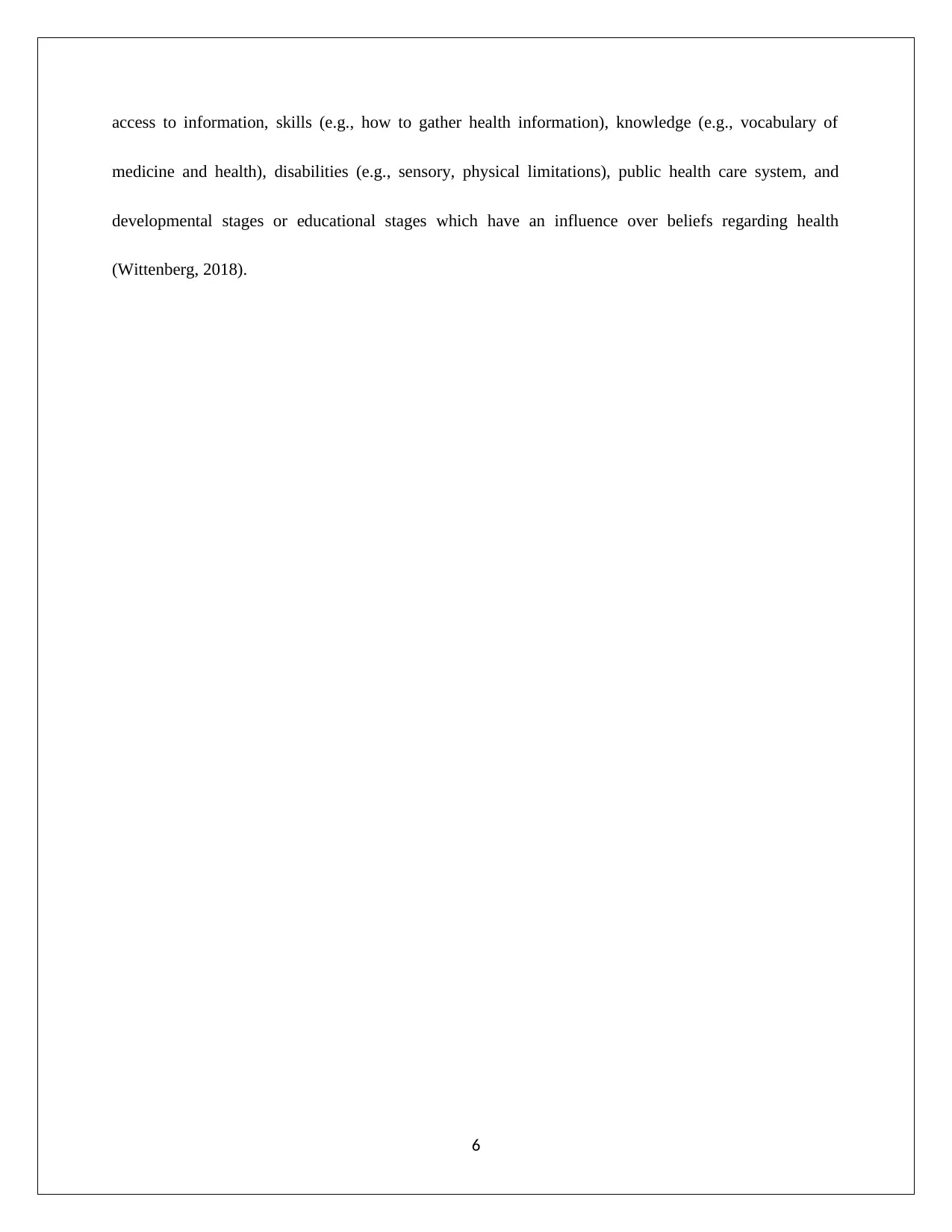
access to information, skills (e.g., how to gather health information), knowledge (e.g., vocabulary of
medicine and health), disabilities (e.g., sensory, physical limitations), public health care system, and
developmental stages or educational stages which have an influence over beliefs regarding health
(Wittenberg, 2018).
6
medicine and health), disabilities (e.g., sensory, physical limitations), public health care system, and
developmental stages or educational stages which have an influence over beliefs regarding health
(Wittenberg, 2018).
6
⊘ This is a preview!⊘
Do you want full access?
Subscribe today to unlock all pages.

Trusted by 1+ million students worldwide
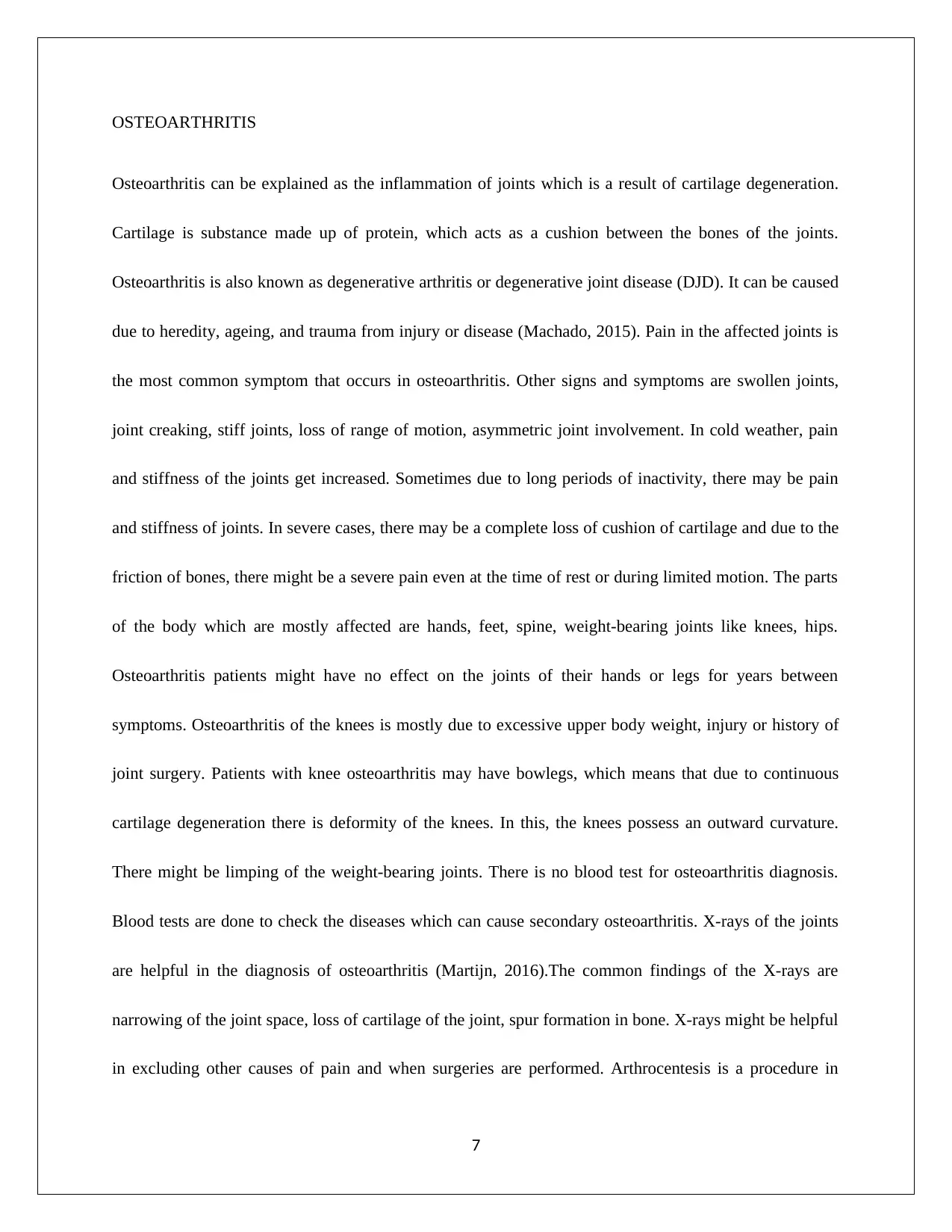
OSTEOARTHRITIS
Osteoarthritis can be explained as the inflammation of joints which is a result of cartilage degeneration.
Cartilage is substance made up of protein, which acts as a cushion between the bones of the joints.
Osteoarthritis is also known as degenerative arthritis or degenerative joint disease (DJD). It can be caused
due to heredity, ageing, and trauma from injury or disease (Machado, 2015). Pain in the affected joints is
the most common symptom that occurs in osteoarthritis. Other signs and symptoms are swollen joints,
joint creaking, stiff joints, loss of range of motion, asymmetric joint involvement. In cold weather, pain
and stiffness of the joints get increased. Sometimes due to long periods of inactivity, there may be pain
and stiffness of joints. In severe cases, there may be a complete loss of cushion of cartilage and due to the
friction of bones, there might be a severe pain even at the time of rest or during limited motion. The parts
of the body which are mostly affected are hands, feet, spine, weight-bearing joints like knees, hips.
Osteoarthritis patients might have no effect on the joints of their hands or legs for years between
symptoms. Osteoarthritis of the knees is mostly due to excessive upper body weight, injury or history of
joint surgery. Patients with knee osteoarthritis may have bowlegs, which means that due to continuous
cartilage degeneration there is deformity of the knees. In this, the knees possess an outward curvature.
There might be limping of the weight-bearing joints. There is no blood test for osteoarthritis diagnosis.
Blood tests are done to check the diseases which can cause secondary osteoarthritis. X-rays of the joints
are helpful in the diagnosis of osteoarthritis (Martijn, 2016).The common findings of the X-rays are
narrowing of the joint space, loss of cartilage of the joint, spur formation in bone. X-rays might be helpful
in excluding other causes of pain and when surgeries are performed. Arthrocentesis is a procedure in
7
Osteoarthritis can be explained as the inflammation of joints which is a result of cartilage degeneration.
Cartilage is substance made up of protein, which acts as a cushion between the bones of the joints.
Osteoarthritis is also known as degenerative arthritis or degenerative joint disease (DJD). It can be caused
due to heredity, ageing, and trauma from injury or disease (Machado, 2015). Pain in the affected joints is
the most common symptom that occurs in osteoarthritis. Other signs and symptoms are swollen joints,
joint creaking, stiff joints, loss of range of motion, asymmetric joint involvement. In cold weather, pain
and stiffness of the joints get increased. Sometimes due to long periods of inactivity, there may be pain
and stiffness of joints. In severe cases, there may be a complete loss of cushion of cartilage and due to the
friction of bones, there might be a severe pain even at the time of rest or during limited motion. The parts
of the body which are mostly affected are hands, feet, spine, weight-bearing joints like knees, hips.
Osteoarthritis patients might have no effect on the joints of their hands or legs for years between
symptoms. Osteoarthritis of the knees is mostly due to excessive upper body weight, injury or history of
joint surgery. Patients with knee osteoarthritis may have bowlegs, which means that due to continuous
cartilage degeneration there is deformity of the knees. In this, the knees possess an outward curvature.
There might be limping of the weight-bearing joints. There is no blood test for osteoarthritis diagnosis.
Blood tests are done to check the diseases which can cause secondary osteoarthritis. X-rays of the joints
are helpful in the diagnosis of osteoarthritis (Martijn, 2016).The common findings of the X-rays are
narrowing of the joint space, loss of cartilage of the joint, spur formation in bone. X-rays might be helpful
in excluding other causes of pain and when surgeries are performed. Arthrocentesis is a procedure in
7
Paraphrase This Document
Need a fresh take? Get an instant paraphrase of this document with our AI Paraphraser
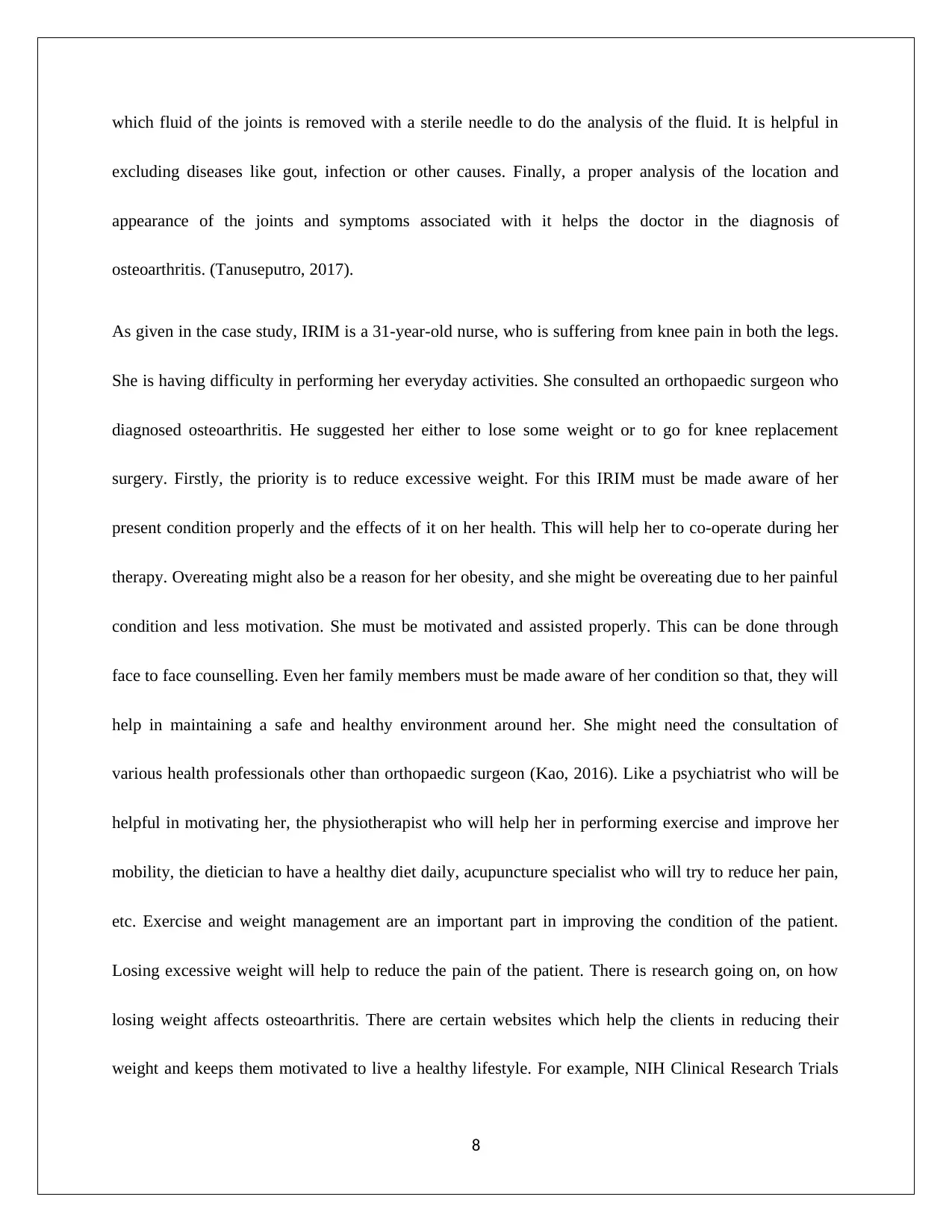
which fluid of the joints is removed with a sterile needle to do the analysis of the fluid. It is helpful in
excluding diseases like gout, infection or other causes. Finally, a proper analysis of the location and
appearance of the joints and symptoms associated with it helps the doctor in the diagnosis of
osteoarthritis. (Tanuseputro, 2017).
As given in the case study, IRIM is a 31-year-old nurse, who is suffering from knee pain in both the legs.
She is having difficulty in performing her everyday activities. She consulted an orthopaedic surgeon who
diagnosed osteoarthritis. He suggested her either to lose some weight or to go for knee replacement
surgery. Firstly, the priority is to reduce excessive weight. For this IRIM must be made aware of her
present condition properly and the effects of it on her health. This will help her to co-operate during her
therapy. Overeating might also be a reason for her obesity, and she might be overeating due to her painful
condition and less motivation. She must be motivated and assisted properly. This can be done through
face to face counselling. Even her family members must be made aware of her condition so that, they will
help in maintaining a safe and healthy environment around her. She might need the consultation of
various health professionals other than orthopaedic surgeon (Kao, 2016). Like a psychiatrist who will be
helpful in motivating her, the physiotherapist who will help her in performing exercise and improve her
mobility, the dietician to have a healthy diet daily, acupuncture specialist who will try to reduce her pain,
etc. Exercise and weight management are an important part in improving the condition of the patient.
Losing excessive weight will help to reduce the pain of the patient. There is research going on, on how
losing weight affects osteoarthritis. There are certain websites which help the clients in reducing their
weight and keeps them motivated to live a healthy lifestyle. For example, NIH Clinical Research Trials
8
excluding diseases like gout, infection or other causes. Finally, a proper analysis of the location and
appearance of the joints and symptoms associated with it helps the doctor in the diagnosis of
osteoarthritis. (Tanuseputro, 2017).
As given in the case study, IRIM is a 31-year-old nurse, who is suffering from knee pain in both the legs.
She is having difficulty in performing her everyday activities. She consulted an orthopaedic surgeon who
diagnosed osteoarthritis. He suggested her either to lose some weight or to go for knee replacement
surgery. Firstly, the priority is to reduce excessive weight. For this IRIM must be made aware of her
present condition properly and the effects of it on her health. This will help her to co-operate during her
therapy. Overeating might also be a reason for her obesity, and she might be overeating due to her painful
condition and less motivation. She must be motivated and assisted properly. This can be done through
face to face counselling. Even her family members must be made aware of her condition so that, they will
help in maintaining a safe and healthy environment around her. She might need the consultation of
various health professionals other than orthopaedic surgeon (Kao, 2016). Like a psychiatrist who will be
helpful in motivating her, the physiotherapist who will help her in performing exercise and improve her
mobility, the dietician to have a healthy diet daily, acupuncture specialist who will try to reduce her pain,
etc. Exercise and weight management are an important part in improving the condition of the patient.
Losing excessive weight will help to reduce the pain of the patient. There is research going on, on how
losing weight affects osteoarthritis. There are certain websites which help the clients in reducing their
weight and keeps them motivated to live a healthy lifestyle. For example, NIH Clinical Research Trials
8
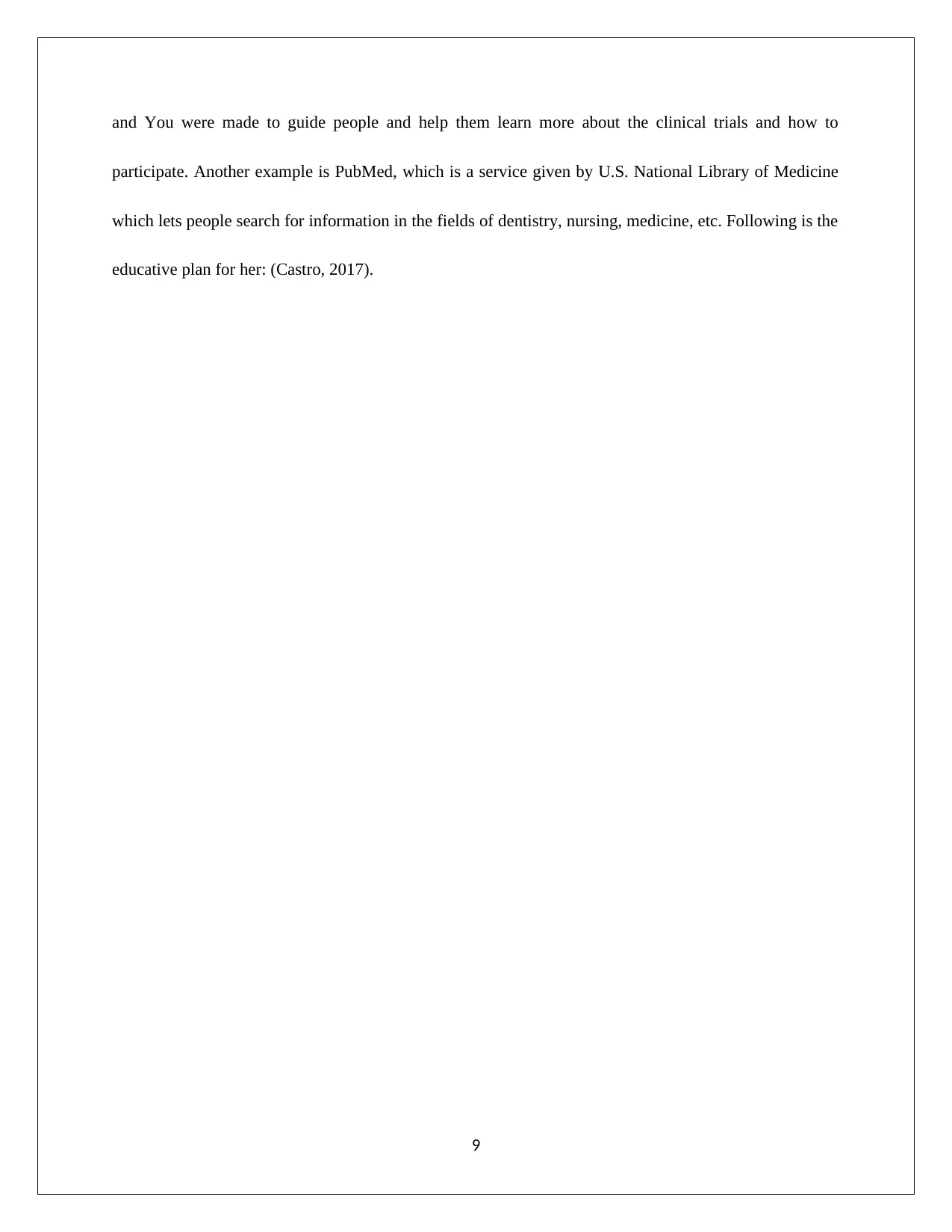
and You were made to guide people and help them learn more about the clinical trials and how to
participate. Another example is PubMed, which is a service given by U.S. National Library of Medicine
which lets people search for information in the fields of dentistry, nursing, medicine, etc. Following is the
educative plan for her: (Castro, 2017).
9
participate. Another example is PubMed, which is a service given by U.S. National Library of Medicine
which lets people search for information in the fields of dentistry, nursing, medicine, etc. Following is the
educative plan for her: (Castro, 2017).
9
⊘ This is a preview!⊘
Do you want full access?
Subscribe today to unlock all pages.

Trusted by 1+ million students worldwide
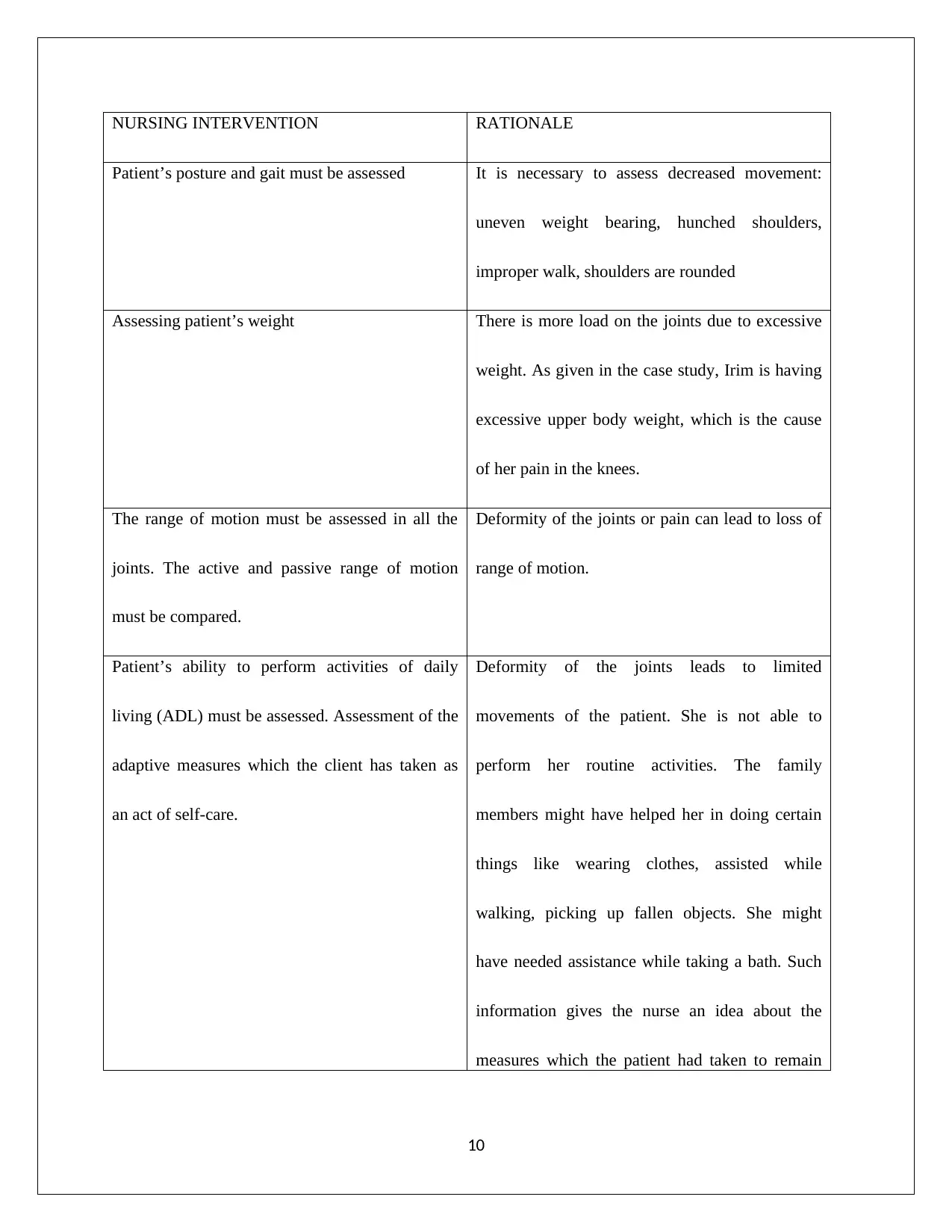
NURSING INTERVENTION RATIONALE
Patient’s posture and gait must be assessed It is necessary to assess decreased movement:
uneven weight bearing, hunched shoulders,
improper walk, shoulders are rounded
Assessing patient’s weight There is more load on the joints due to excessive
weight. As given in the case study, Irim is having
excessive upper body weight, which is the cause
of her pain in the knees.
The range of motion must be assessed in all the
joints. The active and passive range of motion
must be compared.
Deformity of the joints or pain can lead to loss of
range of motion.
Patient’s ability to perform activities of daily
living (ADL) must be assessed. Assessment of the
adaptive measures which the client has taken as
an act of self-care.
Deformity of the joints leads to limited
movements of the patient. She is not able to
perform her routine activities. The family
members might have helped her in doing certain
things like wearing clothes, assisted while
walking, picking up fallen objects. She might
have needed assistance while taking a bath. Such
information gives the nurse an idea about the
measures which the patient had taken to remain
10
Patient’s posture and gait must be assessed It is necessary to assess decreased movement:
uneven weight bearing, hunched shoulders,
improper walk, shoulders are rounded
Assessing patient’s weight There is more load on the joints due to excessive
weight. As given in the case study, Irim is having
excessive upper body weight, which is the cause
of her pain in the knees.
The range of motion must be assessed in all the
joints. The active and passive range of motion
must be compared.
Deformity of the joints or pain can lead to loss of
range of motion.
Patient’s ability to perform activities of daily
living (ADL) must be assessed. Assessment of the
adaptive measures which the client has taken as
an act of self-care.
Deformity of the joints leads to limited
movements of the patient. She is not able to
perform her routine activities. The family
members might have helped her in doing certain
things like wearing clothes, assisted while
walking, picking up fallen objects. She might
have needed assistance while taking a bath. Such
information gives the nurse an idea about the
measures which the patient had taken to remain
10
Paraphrase This Document
Need a fresh take? Get an instant paraphrase of this document with our AI Paraphraser
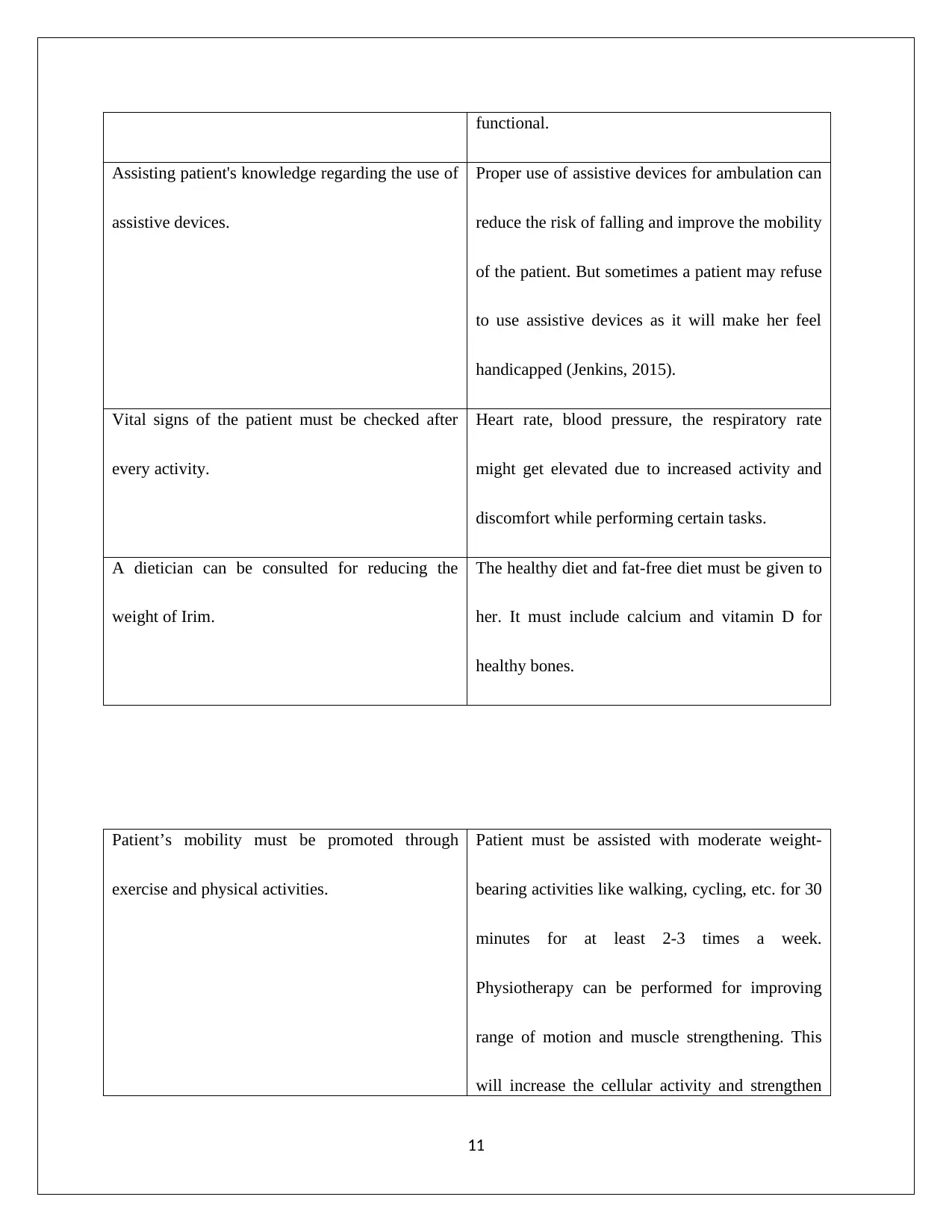
functional.
Assisting patient's knowledge regarding the use of
assistive devices.
Proper use of assistive devices for ambulation can
reduce the risk of falling and improve the mobility
of the patient. But sometimes a patient may refuse
to use assistive devices as it will make her feel
handicapped (Jenkins, 2015).
Vital signs of the patient must be checked after
every activity.
Heart rate, blood pressure, the respiratory rate
might get elevated due to increased activity and
discomfort while performing certain tasks.
A dietician can be consulted for reducing the
weight of Irim.
The healthy diet and fat-free diet must be given to
her. It must include calcium and vitamin D for
healthy bones.
Patient’s mobility must be promoted through
exercise and physical activities.
Patient must be assisted with moderate weight-
bearing activities like walking, cycling, etc. for 30
minutes for at least 2-3 times a week.
Physiotherapy can be performed for improving
range of motion and muscle strengthening. This
will increase the cellular activity and strengthen
11
Assisting patient's knowledge regarding the use of
assistive devices.
Proper use of assistive devices for ambulation can
reduce the risk of falling and improve the mobility
of the patient. But sometimes a patient may refuse
to use assistive devices as it will make her feel
handicapped (Jenkins, 2015).
Vital signs of the patient must be checked after
every activity.
Heart rate, blood pressure, the respiratory rate
might get elevated due to increased activity and
discomfort while performing certain tasks.
A dietician can be consulted for reducing the
weight of Irim.
The healthy diet and fat-free diet must be given to
her. It must include calcium and vitamin D for
healthy bones.
Patient’s mobility must be promoted through
exercise and physical activities.
Patient must be assisted with moderate weight-
bearing activities like walking, cycling, etc. for 30
minutes for at least 2-3 times a week.
Physiotherapy can be performed for improving
range of motion and muscle strengthening. This
will increase the cellular activity and strengthen
11
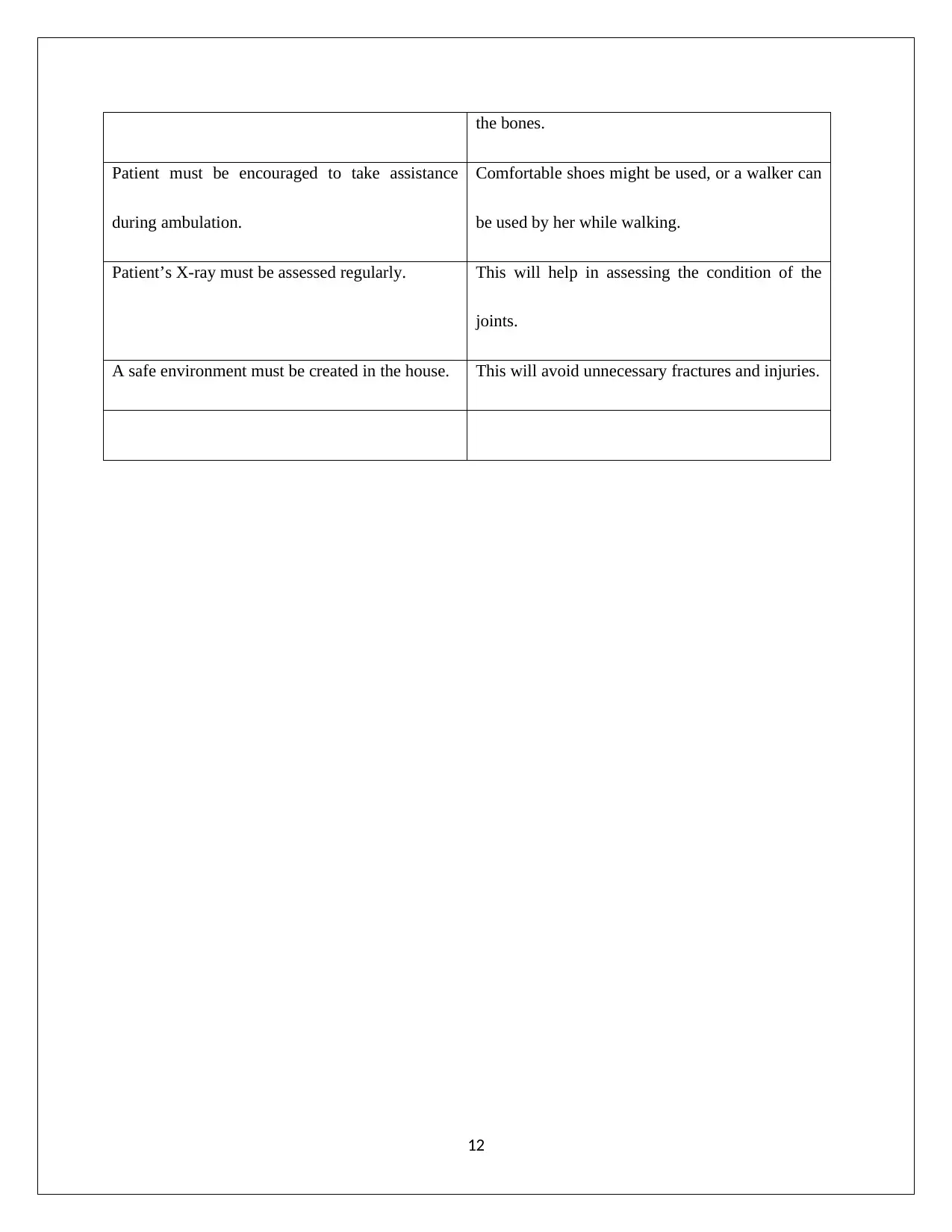
the bones.
Patient must be encouraged to take assistance
during ambulation.
Comfortable shoes might be used, or a walker can
be used by her while walking.
Patient’s X-ray must be assessed regularly. This will help in assessing the condition of the
joints.
A safe environment must be created in the house. This will avoid unnecessary fractures and injuries.
12
Patient must be encouraged to take assistance
during ambulation.
Comfortable shoes might be used, or a walker can
be used by her while walking.
Patient’s X-ray must be assessed regularly. This will help in assessing the condition of the
joints.
A safe environment must be created in the house. This will avoid unnecessary fractures and injuries.
12
⊘ This is a preview!⊘
Do you want full access?
Subscribe today to unlock all pages.

Trusted by 1+ million students worldwide
1 out of 15
Related Documents
Your All-in-One AI-Powered Toolkit for Academic Success.
+13062052269
info@desklib.com
Available 24*7 on WhatsApp / Email
![[object Object]](/_next/static/media/star-bottom.7253800d.svg)
Unlock your academic potential
Copyright © 2020–2025 A2Z Services. All Rights Reserved. Developed and managed by ZUCOL.





